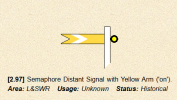The low pressure pneumatic semi automatic signals between Woking and Basingstoke were replaced as part of the electrification in 1965-66
The Southern replaced a number of signals, and installed colour light signals (and built the power boxes at Portsmouth, Woking etc) when electrification and capacity improvements and were done Surbiton-Portsmouth in 1936-37.
There were a number of scattered lower quadrants west of Exeter (they appear in photos of north Devon lines), but I don't know when they went (although most of these lines closed 50-60 years ago).
Although areas of semaphore signals existed after the Bournemouth line electrification, most of these dated from Southern Railway widenings, eg Southampton-Millbrook area and Pokesdown area, and the partial rebuild of Brockenhurst in late 1930s. The Southern railway often installed upper quadrant signals on existing posts (and was very economical, even making new posts from two scrap bullhead rails bolted together)
The new large signalling centres in late 1970s and 1980s (Feltham, Eastleigh, and smaller installations eg Salisbury, Brockenhurst etc) killed off virtually all remaining semaphore signals on South Western. Probably the last to go on a South Western passenger line were those in Fareham area which were added to Eastleigh box (forget the date, but was around 1987-89)


